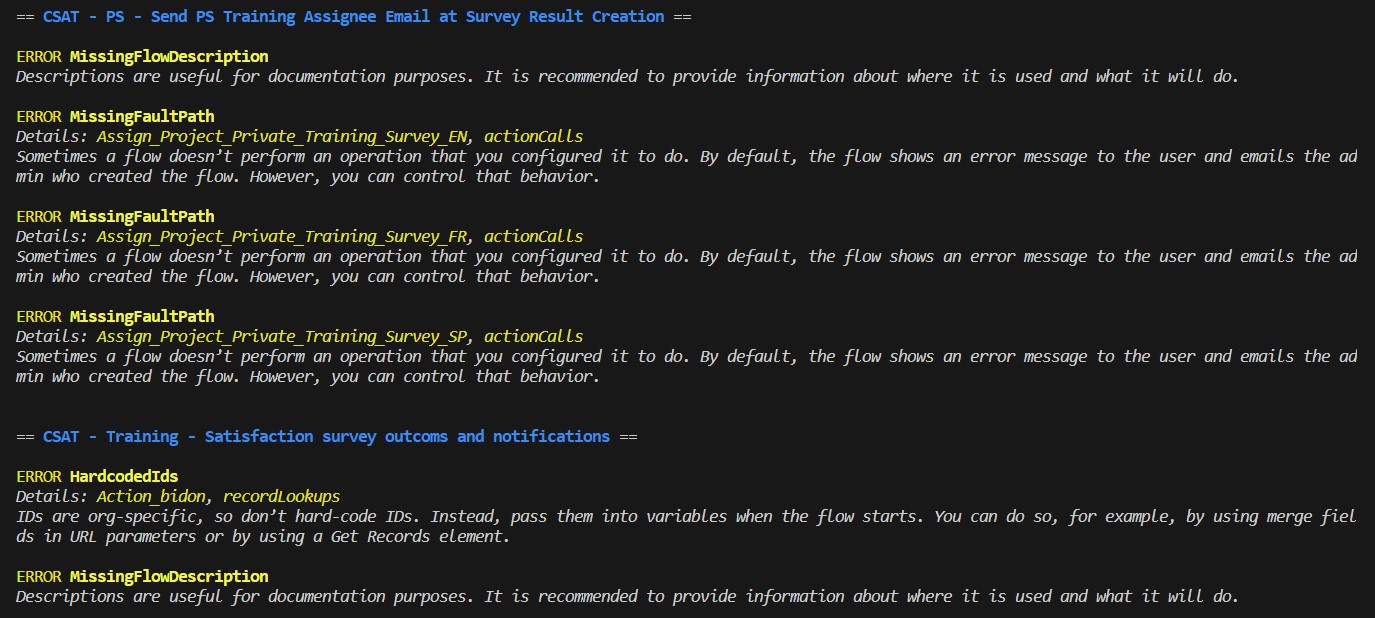Identify potential issues and improvements in Salesforce Flows
*Also available as VS Code Extension
Install with SFDX:
sfdx plugins:install lightning-flow-scannerInstall with NPM:
npm install -g lightning-flow-scannersfdx flow:scan [options] -c, --config <path> provide a path to the configuration file.
-f, --failon provide a threshold level for returning status 1
-p, --sourcepath <C:\..\flow1.flow, C:\..\flow2.flow> provide a comma-separated list of flow paths to scan.
-u, --targetusername <username> retrieve the latest metadata from the target before the scan.
-d, --directory <C:\..\force-app\main\default\flows> provide a directory to scan.
--json set output format as json.
--loglevel=(trace|debug|info|warn|error|fatal) [default: warn] logging level.You can test the scanner by simply opening an existing project that contains flows and running the scan without any configurations or parameters. This way all the default rules are autmatically included in the scan.
sfdx flow:scan
sfdx flow:scan --json
sfdx flow:scan --config path/to/.flow-scanner.json
| Rule | Description |
|---|---|
| Outdated API Version | Introducing newer API components may lead to unexpected issues with older versions of Flows, as they might not align with the underlying mechanics. Starting from API version 50.0, the 'Api Version' attribute has been readily available on the Flow Object. To ensure smooth operation and reduce discrepancies between API versions, it is strongly advised to regularly update and maintain them. |
| Copy API Name | Maintaining multiple elements with a similar name, like 'Copy_X_Of_Element,' can diminish the overall readability of your Flow. When copying and pasting these elements, it's crucial to remember to update the API name of the newly created copy. |
| DML Statement In A Loop | To prevent exceeding Apex governor limits, it is advisable to consolidate all your database operations, including record creation, updates, or deletions, at the conclusion of the flow. |
| Duplicate DML Operation | When the flow executes database changes or actions between two screens, it's important to prevent users from navigating back between screens. Failure to do so may result in duplicate database operations being performed within the flow. |
| Hardcoded Id | Avoid hard-coding IDs as they are org-specific. Instead, pass them into variables at the start of the flow. You can achieve this by utilizing merge fields in URL parameters or employing a Get Records element. |
| Flow Naming Convention | The readability of a flow is of utmost importance. Establishing a naming convention for the Flow Name significantly enhances findability, searchability, and maintains overall consistency. It is advisable to include at least a domain and a brief description of the actions carried out in the flow, for instance, 'Service_OrderFulfillment'. |
| Missing Flow Description | Descriptions play a vital role in documentation. We highly recommend including details about where they are used and their intended purpose. |
| Missing Fault Path | At times, a flow may fail to execute a configured operation as intended. By default, the flow displays an error message to the user and notifies the admin who created the flow via email. However, you can customize this behavior by incorporating a Fault Path. |
| Missing Null Handler | When a Get Records operation doesn't find any data, it returns null. To ensure data validation, utilize a decision element on the operation result variable to check for a non-null result. |
| SOQL Query In A Loop | To prevent exceeding Apex governor limits, it is advisable to consolidate all your SOQL queries at the conclusion of the flow. |
| Unconnected Element | Unconnected elements which are not being used by the Flow should be avoided to keep Flows efficient and maintainable. |
| Unused Variable | To maintain the efficiency and manageability of your Flow, it's advisable to avoid including unconnected variables that are not in use. |
More information on the rules can be found in the lfs-core module documentation.
Create a .flow-scanner.json file in order to configure:
- The severity of violating any specific rule.
- Any known exceptions that should be ignored during scanning.
{
"rules": {
...
},
"exceptions": {
...
}
}Note: if you prefer YAML format, you can create a .flow-scanner.yml file using the same format.
When the severity is not provided it will be error by default. Other available values for severity are warning and note. Define the severity per rule as shown in the following example.
{
"rules": {
"FlowDescription": {
"severity": "warning"
},
"UnusedVariable": {
"severity": "error"
}
}
}Specifying exceptions can be done by flow, rule and result(s), as shown in the following example.
{
"exceptions": {
"AssignTaskOwner": {
"UnusedVariable": [
"somecount"
]
},
"GetAccounts":{
"UnusedVariable": [
"incvar"
]
}
}
}Some rules have additional attributes to configure, such as the expression, that will overwrite default values. These can be configured in the same way as severity as shown in the following example.
{
"rules": {
"APIVersion":
{
"severity": "error",
"expression": "===58"
},
"FlowName":
{
"severity": "error",
"expression": "[A-Za-z0-9]"
}
}
}







